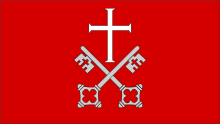Gonfalone of the Church

The Banner of the Holy Roman Church (
Latin: Vexillum; Italian: Gonfalone di Santa Romana Chiesa, occasionally Vessilio di San Pietro, "Standard of Saint Peter") was the battle standard of the Papal States during the Renaissance and a symbol of the Catholic Church. The office of the Gonfalonier of the Church was originally intended to function as its bearer of the Holy See.[1]
Description


The insignia was made of red cloth decorated, initially, with the image of
feast of Corpus Christi
.
History
The Vexillum of Saint Peter came into use under
battle of Lepanto.[1]
Custody of the Vexillum of the Holy Roman Church was entrusted to a high-ranking figure, who assumed the title of Gonfaloniere or Vessillifero di Santa Romana Chiesa (
Gonfalonier of the Holy Roman Church). It was the highest role the pope could grant to a layman, as demonstrated by several of its holders having been kings. Kingly holders included James II of Aragon (1267-1327, king of Sardinia and Corsica, from Pope Boniface VIII) and Ladislaus of Naples (1376–1414, king of Naples, Sicily and Hungary, by Pope Innocent VII
). It was also granted to
- Pope Eugenius IV)
- Gianfrancesco Gonzaga marquess of Mantua (by Pope Julius II)
- (1621–1623)
- Carlo Barberini by his brother Pope Urban VIII(1623–1644)
- Torquato Conti, duke of Guadagnolo, by Urban VIII after Carlo's death in 1630
Papal court
.
